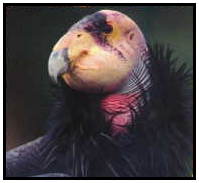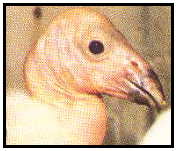California CondorOrder: Falconiformes. Family: Cathartidae. (New World vulture). Scientific Name: Gymnogyps californianus Common Names: California Condor Conservation
Status: Endangered.
Fully protected under the United States Endangered Species Act and
by California law. Apart from a few zoo-raised birds, now largely
extinct in the wild except for a handful of captive-raised, then
released, birds. Numbers are shown below:
By 1986 the wild populations had sunk to only five birds and between them they managed to produce one egg. Unfortunately this had a paper thin skin, something which is usually bought about through poisoning from DDT. As the condor is at the top of the food chain it accumulates anything taken in by the animals it feeds off, including suffering the effects of various poisons. In a matter of months two of the wild birds had died and the remaining three were taken into captivity. A number of conservationist groups were against the captive raising of this bird and strongly felt it should simply be allowed to 'die with dignity'. The Audubon Society sued to prevent the birds being taken into captivity and the Chumash Indians, who consider the bird sacred, demanded all captive birds be released on Santa Cruz Island. An enormous political debate ensued. Good sense won the day, the three remaining California Condors were captured and joined twenty-four others in captivity. The main method of capture was rocket-propelled nets placed at meat baits. The California Condor has been protected since 1953 and was listed as an Endangered species in 1971, but shooting of them continued right up until the 1980s with a California Condor always being a highly prized hunting trophy. Though the birds were never specifically hunted for sport such a large, weird-looking target coming into range was just too tempting. Studies in the 1960s estimated that at least three California Condors were being illegally shot each year. At the same time, the number being successfully fledged was put at only two. Despite the shootings, the only recorded prosecutions for killing/shooting at California Condors was one in 1908 where the guilty party was fined US$50 (resulted in the bird's death) and another in 1992 where two men shot at, but did not kill, a released bird. They were indicted but one skipped to Mexico; the other was fined US$1,500 and given three years probation. The unfortunate truth is that man has always been the California Condor's biggest enemy and there is little else able to prey on it. It is worth noting that at least 288 skins of the California Condor are known to be in museums; half of these were collected between 1881 and 1910, by which time the condors were already becoming rare. An increasing use of land for agricultural purposes was probably the primary reason for the sudden and rapid decline in these birds. This was coupled with a growing trend for farmers to bury carcasses rather than leave them lying, a situation which left the birds short of food. Any carcasses which were left lying often contained strychnine which ranchers inserted into dead cattle to kill wolves and coyotes. Everything seemed stacked against the California Condor. Not only was it frequently shot at and short of food, but if it fed upon the carcass of a shot animal it would ingest significant quantities of lead. In one famous case, an ill California Condor was taken in for treatment. After fifteen days of nursing and twenty-four monitoring, she still died and x-rays were done to help determine the cause of death. It was found that the bird had been shot and her breast contained eight pellets. However this was not the reason for her demise; she had died from a ninth pellet which had been ingested. Lead and DDT both accumulate in the body until they prove fatal. Despite all of these things the California Condor has never developed a great fear of man. In fact, exactly the opposite is the case. The more conspicuous and noisy people are the closer the curious condor approaches. Rescue & Recovery: The birds have adapted reasonably well to captivity. Zoo raising of young is at present the only realistic option available and the California Condor is now well into the cycle of captive breeding at the end of which attempts are made to reintroduce the birds back into the wild. Keepers have to be careful that the chicks do not imprint on the humans who hand-rear them. If this occurs the birds will not live normal lives and no consideration can ever be given to releasing them. To avoid this, San Diego Zoo uses condor-shaped glove puppets to convince the chicks that they are, indeed, condors and not humans. In 1986 the efforts of Los Angeles and San Diego Zoos resulted in the raising of twenty-four chicks. The first captive-bred California Condors were released in southern California in 1992; a second population has also been started in Arizona, with more birds being released each year. A minimum of 150 birds in each group is required for the population to become self-sustaining. As things stand, such extensive attempts have been made to bring this bird back from the brink of extinction that no bird in the world has had more money or expertise invested in it. However, despite a variety of attempts aimed at ensuring the survival of this species, these birds have dwindled to such a stage where it may very well be impossible for them to make a recovery. The release project will be thoroughly evaluated after five years. Should this show that the mortality rate of the population is greater than 40% or the birds have not learned to scavenge for food on their own the project may be ended. This may not be all the fault of the birds themselves. Grazing lands have become fragmented and severely diminished; there may simply not be enough food to support a population of California Condors which are large enough to be self-sustaining. Released birds are in areas which was once part of their natural range; they are being encouraged to stay here through offerings of uncontaminated carcasses. Of the released birds to date, five have died, four being due to contact with power lines and one through ingesting anti-freeze. Seven others have shown an over-interest in human activities or taken to dangerous actions like perching upon power lines. As this placed their lives at risk these birds have been recaptured with initial attempts made to release them in more remote areas. This was not successful, with the birds returning each time to their first release point. They are now back in captivity and form a part of the captive breeding program. Altogether, though the birds have bred quite freely in captivity the release process has not yet been particularly successful.
A point worth noting here is that strong speculation exists these birds reached their peak of evolution around 200,000 years ago and that the remaining birds are relics of a bygone age, destined to become extinct anyway. Though man no doubt hastened their demise, it is possible extinction would have occurred even without this interference. Geographical Range: Originally ranged over Florida, much of eastern North America, the Sierra Nevada and the Rocky Mountains. After the ice age seems to have retreated to the western highlands. Presently most birds are confined to zoos. Habitat: Tropical forests and Savannah. Physical Characteristics: A huge bird (possibly the largest bird of prey) of 114-140 centimetres and with a three metre wingspan. Male and female birds are alike, having a black plumage with bluish metallic reflections and white bars beneath the wings. The head and neck skin is an orange colour with there being a purple patch on the lower neck. White bills and red eyes. Very long-lived with some surviving for fifty years in zoos; possibly may live as long as eighty years. The California Condor is able to glide as far as 16 kilometres without a single flap of the wings. Soaring such as this requires the right thermals and in the case of bad weather or calm conditions these vultures tend to stay firmly grounded. Even on good flying days they stay at the roost for up to fifteen hours a day and out of breeding season their main activities are roosting and foraging. Food: At its peak, a few hundred thousand years ago to ten thousand years ago, (Pleistocene period) the California Condor probably fed on the carcasses of giant sloths, elephant and rhinoceros; it may also have dined upon the remains of beached whales. Over time, its number fluctuated with a gradual increase after domestic cattle came onto the scene. Until the final condor entered captivity that remained its primary source of food with these birds ranging up to 200 miles in order to feed. They have never been known to attack live creatures, confining themselves to carrion which usually came from large carcasses. In captivity most of these birds are fed chunks of horse meat supplemented by pre-prepared bird of prey and feline mixtures. Young birds are fed a diet of chopped rats and mice. Reproduction: California Condors mate for life and commence breeding later in life (around five to seven years old). The male displays to his prospective mate who then lays a solitary egg in a cave or hole in the cliff. Both parents incubate the egg for about fifty days and the young then remain in the nest for several months. They are fed and tended for a year, even after they take flight. Reproduction rates for a pair of birds is only one egg for every two years, so without human intervention this bird would have had no possible hope of self-recovery. Historically, the California Condor was known to breed only in California and even at the best of times many eggs were lost. They either rolled from the nest when a parent was distracted, or else a frightened bird took to the wing clutching the egg in its claws. |


